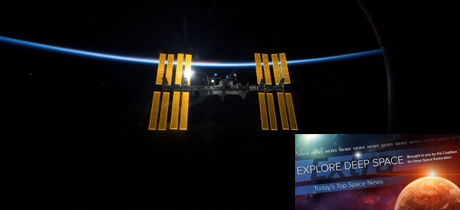In Today’s Deep Space Extra… Space Station’s global partners are discussing the future of the six person orbiting laboratory, which is soon to mark its 17th year of continuous human occupation, and what might come next in the human exploration of space.
National Space Council’s first meeting to be livestreamed Thursday
Human Space Exploration
ISS partners seek clarity on Station’s long-term future
Space News (10/3): Currently, operations by the International Space Station’s five principle partners are to end in 2024, though the outpost is designed to last longer. During a panel discussion at last week’s International Aeronautical Conference in Australia, participants argued for more clarity about the Station’s long term future sooner, than later. The outcome could pace U.S. commercial space investments.
Astronaut-photographer Terry Virts shares ‘view from above’
Collectspace.com (10/3): Three hundred photos fill a new book from NASA astronaut turned author Terry Virts. “I really wanted to capture what it is like to fly a space mission from common events like launch and landing and spacewalking, but also what it was like to see Earth for the first time, or experience emergencies while in space, or learn how to float,” Virts, who retired from NASA’s astronaut corps in 2016, told Collectspace.com.
Space Science
2017 Nobel Prize goes to gravitational waves
Sky & Telescope (10/3): In Berlin on Tuesday, the Nobel Prize for physics went to scientists from MIT and Caltech for their work on the Laser Interferometer Gravitational-Wave Observatory, or LIGO, a technology that detected gravitational waves for the first time in 2015. Existence of the waves was predicted by Albert Einstein. The detections came from waves generated by a distant, long ago black hole merger.
How gravitational waves work (infographic)
Space.com (10/3): You can’t see them, but gravitational waves are out there, just as Einstein predicted. A graphic presentation helps to explain their presence and why the confirmation by three scientists earned them a Nobel Prize for physics.
Other News
On October 4, 1957, the Soviets shocked the world with a shiny metal ball: Sputnik
Washington Post (10/4): The successful launch of the Sputnik-1 satellite 60 years ago today by the former Soviet Union inaugurated the Space Age. And it caught many in Washington and elsewhere by surprise. Who knew what future satellites would be capable of? It seems almost anything.
NASA’s predawn rocket launch will test a supersonic parachute
Space.com (10/3): A sounding rocket scheduled for launch from NASA’s Wallops Island Flight Facility on Virginia’s Eastern Shore is to test parachute technologies for spacecraft destined to land on Mars. The Advanced Supersonic Parachute Inflation Research Experiment, or ASPIRE, was to liftoff Wednesday between 6:45 a.m., to 10:15 a.m., EDT, setting up the test in the Earth’s thin upper atmosphere, where it is possible to simulate conditions high above the Red planet.
Thirty Meter Telescope gets green light to resume construction in Hawaii
Space.com (10/3): The long contested assembly of the Thirty Meter Telescope atop Hawaii’s Mauna Kea volcano was given a green light to resume on September 29 by the state’s Board of Land and Natural Resources. Protesters have stalled efforts to proceed over environmental and cultural objections. Scheduled to come on line in the 2020s, barring further delays, the observatory will investigate the nature of exo-planets, dark energy and dark matter.
NASA to launch up to 72 smallsats with Spaceflight for $5.5 million
Space News (10/3): Seattle based Spaceflight has entered a $5.5 million contract with NASA to arrange small satellite ride shares for as many as 72 cubesats between now and 2020. They will fly as secondary payloads on U.S. launch vehicles only.

